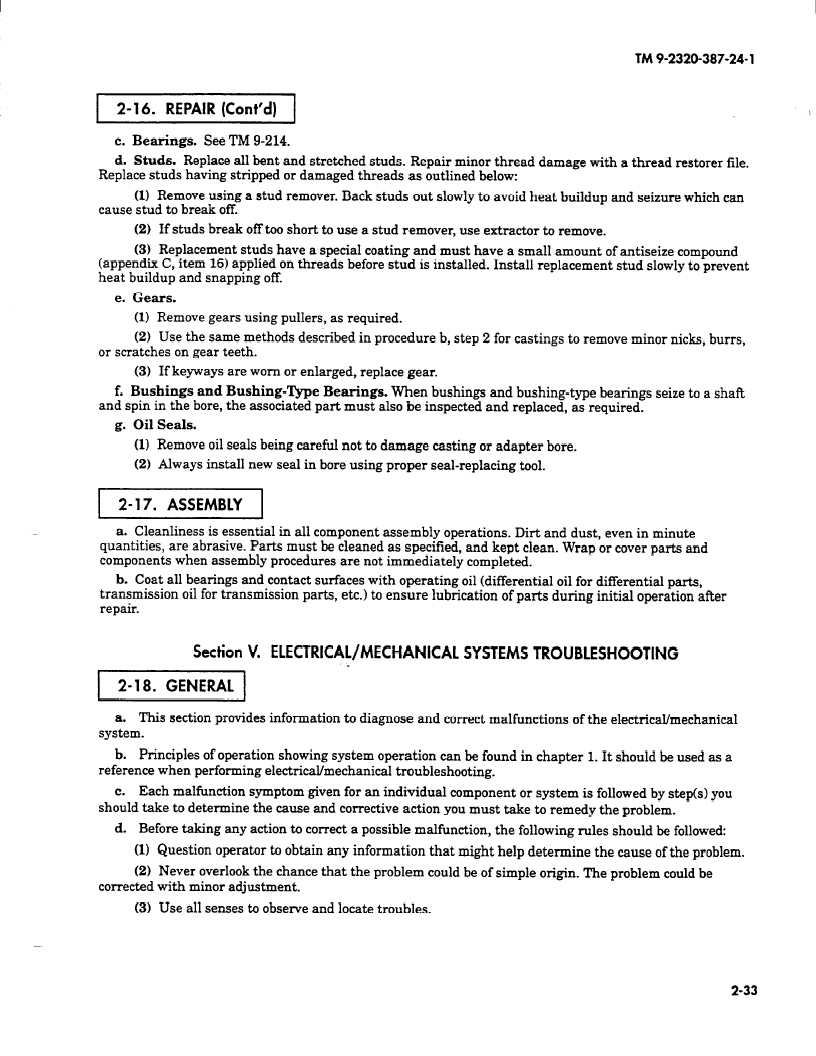TM 9-2320-387-24-l
2-16. REPAIR (Cont’d)
c. Bearings. See TM 9-214.
d. Studs. Replace all bent and stretched studs. Repair minor thread damage with a thread restorer file.
Replace studs having stripped or damaged threads as outlined below:
(11 Remove using a stud remover. Back studs out slowly to avoid heat buildup and seizure which can
cause stud to break off.
(2) If studs break off too short to use a stud remover, use extractor to remove.
(3) Replacement studs have a special coating and must have a small amount of antiseize compound
(appendix C, item 161 applied on threads before stud is installed. Install replacement stud slowly to prevent
heat buildup and snapping off.
e. Gears.
(11 Remove gears using pullers, as required.
(21 Use the same methods described in procedure b, step 2 for castings to remove minor nicks, burrs,
or scratches on gear teeth.
(31 If keyways are worn or enlarged, replace gear.
f. Bushings and Bushing-Type Bearings. When bushings and bushing-type bearings seize to a shaft
and spin in the bore, the associated part must also be inspected and replaced, as required.
g. Oil Seals.
(11 Remove oil seals being careful not to damage casting or adapter bore.
(21 Always install new seal in bore using proper seal-replacing tool.
2- 17. ASSEMBLY
a. Cleanliness is essential in all component assembly operations. Dirt and dust, even in minute
quantities, are abrasive. Parts must be cleaned as specified, and kept clean. Wrap or cover parts and
components when assembly procedures are not immediately completed.
b. Coat all bearings and contact surfaces with operating oil (differential oil for differential parts,
transmission oil for transmission parts, etc.) to ensure lubrication of parts during initial operation after
repair.
Section V. ELECTRICAL/MECHANICAL SYSTEMS TROUBLESHOOTING
pKxK--2_18.
‘-
a. This section provides information to diagnose and correct malfunctions of the electrical/mechanical
system.
b. Principles of operation showing system operation can be found in chapter 1. It should be used as a
reference when performing electrical/mechanical troubleshooting.
c.
Each malfunction symptom given for an individual component or system is followed by step(s) you
should take to determine the cause and corrective action you must take to remedy the problem.
d. Before taking any action to correct a possible malfunction, the following rules should be followed:
(11 Question operator to obtain any information that might help determine the cause of the problem.
(2) Never overlook the chance that the problem could be of simple origin. The problem could be
corrected with minor adjustment.
(3) Use all senses to observe and locate troubles.
2-33

